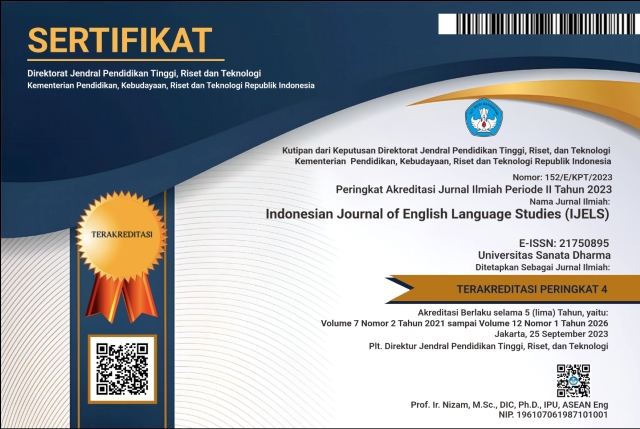Reading Disability in Indonesian Children’s Literature
(1) Universitas Negeri Yogyakarta
(*) Corresponding Author
Abstract
The purpose of this article is to examine the representation of disability and to identify the discourse resulted from the pattern of its portrayal in four selected Indonesian children’s shorts stories, namely “Kacamata UFO”, “Gadis Penari”, “Bapak Si Dono”, and “Cerita Rion dengan Sebelah Mata” published in Bobo magazine. Applying the lens of Said’s Orientalism, this content analysis study shows that children with disabilities are presented as weak, dependent, not productive, an object of curiosity and violence, and a vehicle for the growth of other characters in the story. This study concludes that literacy on disability for Indonesian people is significant. Such writing is to provide a positive image and reduce the negative stereotype which is currently shared among society.
Keywords
Full Text:
PDFReferences
Amannullah, G. (2016). Measuring disability in Indonesia. Approaches Used to Measure Disability through Censuses: National Experiences. https://unstats. un.org/unsd/demographic-social/ meetings/ 2016/Bangkok-disability- measurement-and-statistics/Session- 6/Indonesia.pdf
Bold, M. R. (2019). Inclusive Young Adult Fiction Authors of Colour in the United Kingdom. Springer Nature.
Boudreaux, B. (2006). The Representation of the Environment in Children’s Literature [University of New Orleans]. https://scholarworks.uno.edu/ td%0A
Byrne, J. (2007, July 27). Disability in Indonesia. https://www.insideindonesia.org/disab ility-in-indonesia
Cameron, L., & Suarez, D. C. (2017). Disability in Indonesia: What can we learn from the data? August, 1–65. https://www.monash.edu/ data/asset s/pdf_file/0003/1107138/Disability-
in-Indonesia.pdf
Coleman-king, C., & Groenke, S. L. (2015). Enhancing Antiracist Teacher Education: The ALAN Review, Winter, 57–67.
Couser, G. T. (2009). Signifying Bodies; Disability in Contemporary Life Writing. The Universit of Michigan Press.
Danielson, K. E., & LaBonty, J. (2009). Reading and Responding to Children’s Books About Bullying. Ohio Journal of English Language Arts, 49(1), 31–38. http://proxy. libraries.smu.edu/login?url=http://sear ch.ebscohost.com/login.aspx?direct=tr ue&db=eue&AN=43294568&site=eh ost-live&scope=site
David, T. (2000). Narrative Prosthesis: Disability and the Dependencies of Discourse. The Universit of Michigan Press.
Dewi, N. (2017). People and Nature in Asian Stories: Reading and Writing Materials for Eco Education. K@Ta, 19(1), 254–259. https://doi.org/
9744/kata.19.1. 39-46
Iwai, Y. (2013). Multicultural children’s literature and teacher candidates’ awareness and attitudes toward cultural diversity. International Electronic Journal of Elementary Education, 5(2), 185–198.
Jeanne, B., & Harms, M. (2019). Poetry and The Environment. 37(6), 30–34.
Kristanti, F. (2016). Dignifying Children Through Inclusive Children’S Literature. Journal of Language and Literature, 16(01), 63–69. https://doi. org/10.24071/joll.2016.160108
Mcllhagga, K. K. A. (2016). Children’s Literature in elementary Teacher Education Curricula: A Repertoire for Teacher as Coach, Critic, and Curator [Michigan State University]. Journal of Knowledge Management, 2(2). https://doi.org/10.1016/j.cya.2015.11. 011
Nikolajeva, M. (2014). Reading for Learning: Cognitive Approaches to Children’s Literature (Vol. 37). John Benjamin Publishing Company. https://doi.org/10.14811/clr.v37i0.189
Priyanti, N. (2018). Representations of People with Disabilities in an Indonesian Newspaper: A Critical Discourse Analysis. Disability Studies Quarterly. https://doi.org/10.18061/ dsq.v38i4.5818
Rapley, M. (2004). The Social Construction of Intellectual Disability. Cambridge Univesity Press.
Rohwerder, B. (2018). Disability stigma in developing countries. K4D Helpdesk Report, 26. https://assets.publishing. service.gov.uk/media/5b18fe3240f0b6 34aec30791/Disability_stigma_in_dev eloping_countries.pdf
Sajid, M. J. (2015). Ideology in Text Books.
(06), 575–581.
Sedgwick, F. (2010). Inspiring Children to Read and Write for Pleasure. In Inspiring Children to Read and Write for Pleasure. https://doi.org/10.4324/ 9780203845325
Segal, R. and B. R. (2014). Children and Their Urban Environment: Changing Worlds by Claire Freeman and Paul Tranter. Children, Youth and Environemnt, 24(3), 236–238.
Sugiarto, T., & Purbani, W. (2019). The Interdependence Between Human and Nature in Craighead Jean George’s My Side of the Mountain. Diksi, 27(2), 102–109.
Tsaputra, A. (2016). Portrayals of People ( a Case Study on Three Indonesian Major. 3(1), 1–11.
Wardany, O. F. (2018). The Needs of Picture Books for Fostering Disability Awareness. International Conference On Child-Friendly Education, July, 281–285.
DOI: https://doi.org/10.24071/ijels.v6i1.2693
Refbacks
- There are currently no refbacks.

This work is licensed under a Creative Commons Attribution-ShareAlike 4.0 International License.
IJELS Journal Sinta 4 Certificate (S4 = Level 4)
We would like to inform you that Indonesian Journal of English Language Studies (IJELS) has been nationally accredited Sinta 4 by the Ministry of Education, Culture, Research and Technology of the Republic of Indonesia based on the decree No. Surat Keputusan 152/E/KPT/2023. Validity for 5 years: Vol 7 No 2, 2021 till Vol 12 No 1, 2026

This work is licensed under CC BY-SA.
Creative Commons Attribution-ShareAlike 4.0 International License
IJELS e-ISSN 2715-0895; IJELS p-ISSN 2442-790X
Indonesian Journal of English Language Studies (IJELS) is published twice a year, namely in March and September, by the English Language Studies (ELS) of the Graduate Program of Sanata Dharma University, Yogyakarta, Indonesia.


 IJELS p-ISSN:
IJELS p-ISSN: 











